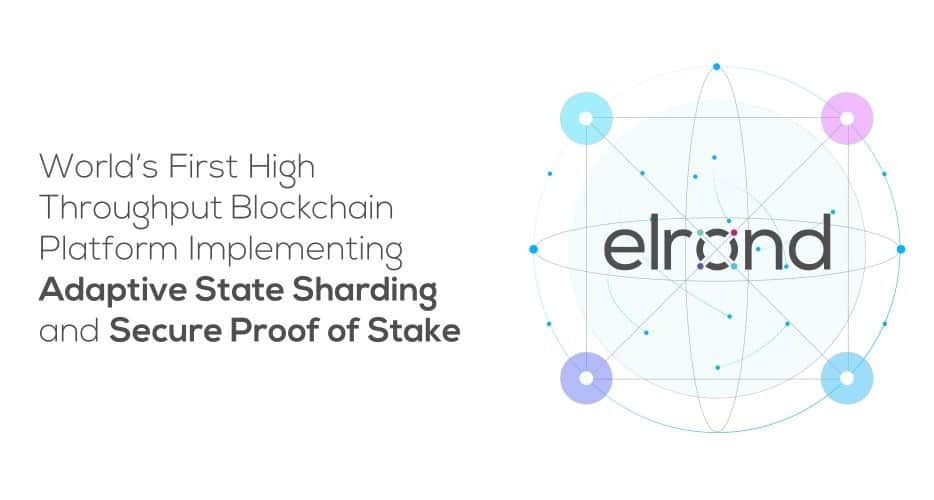

The latest IEO to be held on Binance Launchpad will be Elrond Network (ERD). While it was founded in late 2017, you may not have heard of this ultra-high-throughput public blockchain yet.
That’s because the team has been quietly building. Its CEO and founder Beniamin Mincu helped to take the NEM project from a concept to reality.
With a name that has continually garnering respect, Binance doesn’t allow just any company to hold an IEO on its Launchpad. The vetting process is long and due diligence is carried out over a strenuous process on the team, the tech, the market possibilities, and USPs.
Mincu has more than four years of experience working with blockchain start-ups. He was part of the NEM core team, and also invested in and supported sharding blockchain projects such as Zilliqa.
Despite not having held a token sale yet or making many headlines, actions speak louder than words when it comes to Elrond Network. By July 2018, the company released its prototype for a decentralised sharding format blockchain that would produce more than 1,000 TPS (transactions per second). This would make it scalable and secure enough to be used for real-world applications.
There have been plenty of projects that speak about scaling and sharding, using a mixture of algorithms to achieve consensus that aren’t as high-energy as Proof-of-Work. But there always seems to be a trade-off between decentralisation and security.
Elrond Network claims to be the world’s first high-throughput blockchain implementing adaptive state sharding and Secure Proof-of-Stake. In less than one year from unveiling its plans, Elrond released its inaugural testnet in May 2019. And it has already exceeded 12,000 TPS.
On top of that, the team has been innovating as they’ve developed the blockchain. Elrond Network now also includes other technologies such as Schnorr signatures and BLS signatures.
Coin Rivet spoke to Elrond Network’s CEO Beniamin Mincu to find out more about the IEO process and why the company chose to go down this route. He said:
“An IEO is the most effective way of achieving several things at the same time: 1) maximum marketing and community outreach, 2) very wide investor distribution, and 3) it’s very effective for fundraising and the KYC/AML process. We have considered all other options, and none were close in terms of maximising all three in the same way.”
The death of the ICO has been well documented. While many look back on the glory days of 2017 with nostalgia, it wasn’t always easy raising money overnight. More often than not, the people who made the loudest noise received the funds – whether their project was legitimate or not.
Through IEOs, investors get the peace of mind that due diligence has been carried out for them. And the token issuers get to piggyback off the resources of its host – in this case, Binance.
Based on all the attention this mega-corporation receives and its huge footprint in the industry, it should be no surprise that Elrond Network would want Changpeng Zhao’s company to hold its IEO.
Mincu enthused: “Binance is at this point the largest and fastest-growing exchange in the world. By performing an IEO on them, we get to partner with the largest player in the blockchain space and the opportunity to connect with the largest audience. Distribution is key to any start-up and instrumental for blockchain networks, so the opportunity to launch on Binance is an unparalleled edge for a project preparing for listing.”
This isn’t the first time we’ve heard talk of blockchains achieving stability and speed through the sharding technique. In fact, one platform registering some noteworthy results right now is Zilliqa. So, what makes Elrond different and why does Mincu believe that his blockchain will render many others obsolete?
“Elrond is a high-throughput blockchain platform based on adaptive state sharding and Secure Proof-of-Stake. The big difference between Elrond and Zilliqa is that while Elrond is doing state sharding (state, network, and transaction sharding), Zilliqa only does network and transaction sharding. In addition to that, while Elrond has pioneered a new version of the Secure Proof-of-Stake consensus, which eliminates PoW energy and computational waste altogether, Zilliqa has only come up with an improved version of PoW, but no Proof-of-Stake.”
Mincu is so confident in his creation that he points out that Elrond has already achieved 12,000 TPS and is looking to amplify that to the tens of thousands over the next three to six months. So how will the blockchain space look in the not-to-distant future?
“Once Elrond is live, most of the other earlier scalability solutions will likely become obsolete over time.”
The IEO is running on Binance Launchpad through a lottery system available to BNB holders. If you’re interested in finding out more about it, check out the information on Binance here.
Denver, Colorado, 24th February 2025, Chainwire
Denver, Colorado, 20th February 2025, Chainwire
Washington, D.C., 18th February 2025, Chainwire
Dubai, UAE, 27th January 2025, Chainwire
Those who enter the market at this time may be surprised to hear that Bitcoin…
George Town, Grand Cayman, 22nd November 2024, Chainwire